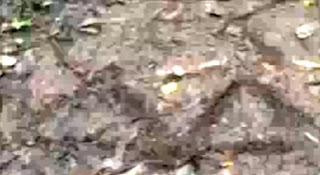http://it.stlawu.edu/~dmelvill/mesomath/Numbers.html
http://www.ancientscripts.com/akkadian.html
These are the places the cuneiform has been found (listed in chronological order):
- on the side of the PIE HQ
- on the walls of the PIE HQ
- on the trail in BikeRiley's video
- on the PIE guys' bill at the coffee shop
 Pictured above is the cuneiform on the outside of PIE HQ. Although they look like fecal smudges, the PIE guys have assured us that--despite how much it stinks--it's not actually poop. (Thank god.)
Pictured above is the cuneiform on the outside of PIE HQ. Although they look like fecal smudges, the PIE guys have assured us that--despite how much it stinks--it's not actually poop. (Thank god.)
Anyway, it can be seen when comparing the cuneiform numbers to the syllabic writing that the numberic symbols are much more simple. So, taking a look at the bags on the wall, one might say that the markings on them are numbers, not syllabic letters. However, this leads to problems in translastion, as I'll outline below.
Assuming that these are indeed numbers, the symbols on the first bag become hard to translate. In the webpage listed for numerical translation, there is no direct matching number for these symbols. The two possible interpretations I see are that it could represent the number 3, by just counting the number of wedges; or 62, by counting the first wedge as a separate digit (meaning 60 in the base-60 numbering system) and the other two wedges as 2 (though they are inexplicably stacked vertically). The next two bags are easy to convert: 10 and 4. So if the bags were numbers, then they might mean either 3-10-4 or 62-10-4.
If you take a look at them as if they were script, however, the first bag is translatable. It is a seemingly relatively easy conversion: the bags say "a-u-za."
As for what any of these possible translations mean, I'm lost. My best guess is that maybe 62-10-4 is a date, meaning April 10, 1962 or October 4, 1962. This actually kind of works in with the next set of cuneiform found... Pictured is the result of the PIE HQ being broken into. There is a lot less to say about the cuneiform here because the symbols are just the ones on the outside of the house written backwards. So, it's either "za-u-a," 4-10-62, or 4-10-3.
Pictured is the result of the PIE HQ being broken into. There is a lot less to say about the cuneiform here because the symbols are just the ones on the outside of the house written backwards. So, it's either "za-u-a," 4-10-62, or 4-10-3.
It seems that it would be quite coincidental if whatever the vandals wanted to write was a different meaning, and it just happened to be the exact same thing they wrote before backwards. So, maybe it's just another representation of the same message. It's entirely possible that it's just another way of writing a date, which could again be either April 10, 1962 or October 4, 1962. These next symbols are found in a video posted by BikeRiley (although it can't be confirmed whether this is actually in-game or not, it seems very legitimate). On the path that he follows to find the strange shadow creature (which looks friggin' sweet, by the way), the above markings are found.
These next symbols are found in a video posted by BikeRiley (although it can't be confirmed whether this is actually in-game or not, it seems very legitimate). On the path that he follows to find the strange shadow creature (which looks friggin' sweet, by the way), the above markings are found.
These are probably the hardest symbols to translate, because they don't seem to be oriented correctly. That is, the triangles are upside-down relative to the crescent. I can't find any number or syllabic letter that has either upside-down vertical-wedges or backwards horizontal-wedges. So I have to idea how to convert them into anything meaningful. The last set of cuneiform markings are on the note for the bill that was given to the PIE guys at the coffee shop where they saw the men in blue suits. Apparently, the guys in the suits paid for Hector and Baron's purchase while threatening them if they "keep going," and at the bottom of this inappropriately-coloured threat were the symbols.
The last set of cuneiform markings are on the note for the bill that was given to the PIE guys at the coffee shop where they saw the men in blue suits. Apparently, the guys in the suits paid for Hector and Baron's purchase while threatening them if they "keep going," and at the bottom of this inappropriately-coloured threat were the symbols.
If translated as numbers, they mean 4. If translated as writing, they mean "za." This doesn't seem to mean a lot.
Really, none of the symbols seem to mean a lot, whether it's because they're really ambiguous or just gibberish. I guess I'll just end this post with the possible translations of each instance of the markings. Hopefully their meaning will become clearer in the future:
3-10-4
62-10-4
a-u-za
4-10-3
4-10-62
za-u-a
???
4
za





